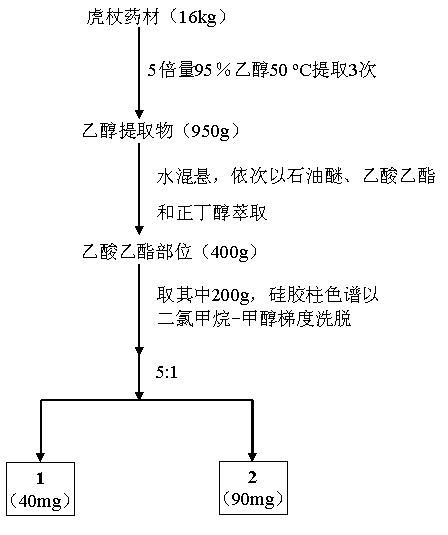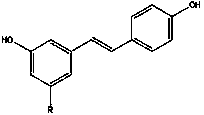Application of toluylene compounds in preparation of anticomplement medicaments
A technology of stilbenes and compounds, applied in the direction of active ingredients of hydroxyl compounds, drug combinations, antipyretics, etc.
- Summary
- Abstract
- Description
- Claims
- Application Information
AI Technical Summary
Problems solved by technology
Method used
Image
Examples
Embodiment 1
[0023] Example 1 Preparation of stilbene compounds
[0024] Polygonum cuspidatum root coarse powder 16kg, extracted 3 times with 5 times the amount of 95% ethanol at 50 o C, each time for 2 hours; the solvent was recovered under reduced pressure to obtain 950 g of extract, which was suspended in distilled water, and extracted with petroleum ether, ethyl acetate and n-butyl Alcohol extraction to obtain 400 g of ethyl acetate extract; 200 g of ethyl acetate extract was subjected to silica gel column chromatography, and gradient elution was performed with dichloromethane, dichloromethane-methanol, and methanol, and the obtained fractions were repeatedly subjected to different eluents. Silica gel column chromatography, RP-18 preparative chromatography and SephadexLH-20 purification, isolate compound resveratrol ( 1 ), polydatin ( 2 );
[0025] Specific steps are as follows:
[0026] 1. The obtained fraction was eluted with dichloromethane-methanol (5:1), and after repeated c...
Embodiment 2
[0028] Example 2 Anti-complement classical pathway test in vitro
[0029] Take 0.1ml of complement (guinea pig serum), add BBS buffer to make a 1:5 solution, and double-dilute with BBS to 1:10, 1:20, 1:40, 1:80, 1:160, 1:320 and 1:640 solution; take 0.1 ml each of 1:1000 hemolysin and 2% SRBC, and dissolve 0.2 ml of each concentration of complement in 0.2 ml BBS, mix well, put into a low-temperature high-speed centrifuge after 30 min in a 37 oC water bath, and spin at 5000 rpm centrifuge at 4 oC for 10 min; take 0.2 ml of supernatant from each tube and place in a 96-well plate, and measure the absorbance at 405 nm; set up a complete hemolysis group (0.1 ml of 2% SRBC dissolved in 0.5 ml of three-distilled water); The absorbance of distilled water lysed blood vessels was used as the standard of total hemolysis, and the hemolysis rate was calculated; the dilution of complement was taken as the X-axis, and the percentage of hemolysis caused by each dilution of complement was p...
Embodiment 3
[0031] Example 3 In vitro anti-complement alternative pathway assay
[0032] Take 0.2 ml of complement (human serum), add AP diluent to prepare a 1:5 dilution solution, and double-dilute to 1:10, 1:20, 1:40, 1:80, 1:160, 1:320 and 1:640 solution; take 0.15 ml of each concentration of complement, 0.15 ml of AP diluent, and 0.20 ml of 0.5% RE, mix well, place in a low-temperature high-speed centrifuge after 30 min in a 37 oC water bath, and centrifuge at 5000 rpm and 4 oC for 10 min; take 0.2 ml of supernatant from each tube in a 96-well plate, and measure the absorbance at 405 nm. At the same time, a complete hemolysis group (0.20 ml 0.5% RE dissolved in 0.3 ml three-distilled water) was set up, and the absorbance of three-distilled water lysed blood vessels was used as the standard of total hemolysis to calculate the hemolysis rate; the dilution degree of complement was taken as the X-axis, and the percentage of the hemolysis caused by each dilution concentration was calcul...
PUM
 Login to View More
Login to View More Abstract
Description
Claims
Application Information
 Login to View More
Login to View More - R&D
- Intellectual Property
- Life Sciences
- Materials
- Tech Scout
- Unparalleled Data Quality
- Higher Quality Content
- 60% Fewer Hallucinations
Browse by: Latest US Patents, China's latest patents, Technical Efficacy Thesaurus, Application Domain, Technology Topic, Popular Technical Reports.
© 2025 PatSnap. All rights reserved.Legal|Privacy policy|Modern Slavery Act Transparency Statement|Sitemap|About US| Contact US: help@patsnap.com



